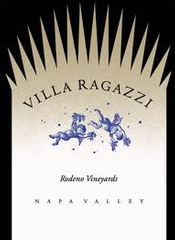|
|
 |

Villa Ragazzi, Napa Valley (California) Sangiovese, Rodeno Vineyards, 2009 ($36): To my delight, after expressing my disillusion with most California Sangiovese wines in a recent column, I have discovered an excellent and exciting Sangiovese from the Napa Valley.  And the wine’s story is almost as good as the wine itself. And the wine’s story is almost as good as the wine itself.
Most people probably know Michaela Rodena as a powerful wine executive who over decades in the business put Domaine Chandon and subsequently St. Supery Vineyards & Winery on the map before retiring in 2009. She is also proprietor, with her husband Gregory, of a 40-acre vineyard in Pope Valley, in northeastern Napa County, that is planted mainly to Cabernet Sauvignon, and a tiny family winery called Villa Ragazzi. Inspired by visits to Tuscany, the couple planted two acres of Sangiovese in 1985 — and their Rodeno Vineyard became the first Sangiovese vineyard in Napa Valley. Although they sell their Cabernet grapes, they chose to vinify their Sangiovese. The 1989 was their first commercial vintage. After phylloxera claimed the vines in 2001, Villa Ragazzi Sangiovese has returned with this 2009 vintage.
The source for the couple’s Sangiovese all those years ago was a winemaker friend who gave them cuttings from an old mixed-variety vineyard in Sonoma for which no records existed. Numerous other wineries in California obtained budwood from these vines to plant Sangiovese themselves. Because the vines turned out to be unusual, U.C. Davis has recognized this Sangiovese as a unique clone, the Rodeno clone.
One of the unusual aspects of the Rodeno clone of Sangiovese, at least at Rodeno Vineyard, is that it produces small clusters of tiny berries and is very low yielding, while Sangiovese in general tends to overcrop. Planted on a rocky hillside in poor, well-drained soil, mainly decomposing limestone, it yields only 1.5 to 2 tons per acre. In 2009, the winery produced only 75 cases of Sangiovese.
The wine is available for sale at the winery and a few top California restaurants also carry it. If you can score a bottle, here’s what you can expect to taste. The color is fairly deep for Sangiovese and has purple tinges that are unusual for this variety. The wine’s aroma is only medium intense but its notes of tart red cherry and wild red berries are vivid and fresh. In your mouth, the wine is dry, rather medium-bodied, and soft-textured, with great depth of acidity along with fine-grained tannins that assert themselves in the rear palate. These tannins are not wimpy, but neither is the wine’s concentrated, fresh, red-fruit flavor (considerably fruitier than a Tuscan Sangiovese); the balance between the tannin and the fruit is perfect, and their interplay is fascinating. Fruity flavors persist on the long finish.
This wine is delightful when you first pour it, and yet it changes quite a lot in the glass. At first, it’s all about lean structure, depth and energy, but with about 30 minutes of exposure to air, the wine becomes fuller, rounder, softer and riper. When you introduce food to the equation -- such as grilled sausages -- the wine’s acidity goes into action, and the wine shows its delicacy and finesse.
This is a splendid Sangiovese, true to its variety and also true to its California upbringing.
92 Points
|
 |
|